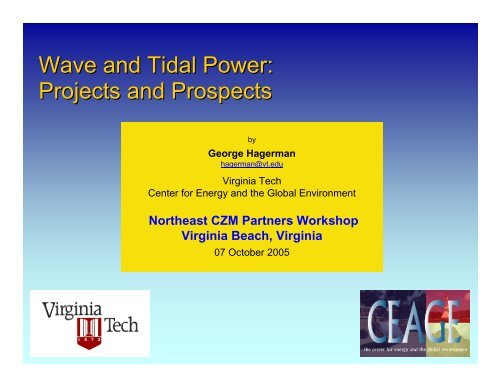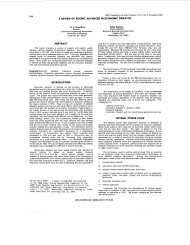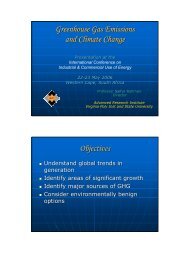Wave and Tidal Power: Projects and Prospects - ceage - Virginia Tech
Wave and Tidal Power: Projects and Prospects - ceage - Virginia Tech
Wave and Tidal Power: Projects and Prospects - ceage - Virginia Tech
Create successful ePaper yourself
Turn your PDF publications into a flip-book with our unique Google optimized e-Paper software.
<strong>Wave</strong> <strong>and</strong> <strong>Tidal</strong> <strong>Power</strong>:<br />
<strong>Projects</strong> <strong>and</strong> <strong>Prospects</strong><br />
by<br />
George Hagerman<br />
hagerman@vt.edu<br />
<strong>Virginia</strong> <strong>Tech</strong><br />
Center for Energy <strong>and</strong> the Global Environment<br />
Northeast CZM Partners Workshop<br />
<strong>Virginia</strong> Beach, <strong>Virginia</strong><br />
07 October 2005
Presentation Outline<br />
• <strong>Wave</strong> Energy Resource: A derived form of solar energy, in<br />
that unequal solar heating of the earth’s surface generates wind,<br />
<strong>and</strong> wind blowing over water generates waves.<br />
• <strong>Wave</strong> Energy Conversion Devices: Three categories:<br />
– Terminator (OWC = oscillating water column, overtopping reservoir)<br />
– Attenuator (Pelamis)<br />
– Point Absorber (Heaving buoy, submerged float)<br />
• <strong>Tidal</strong> Energy Resource: Astronomically-governed <strong>and</strong> thus<br />
highly predictable <strong>and</strong> relatively insensitive to weather conditions.<br />
• <strong>Tidal</strong> In-Stream Energy Conversion Devices: Submerged<br />
turbine on monopile foundation has made most progress.<br />
• Electric <strong>Power</strong> Research Institute <strong>Projects</strong>: Multi-year,<br />
collaborative efforts leading from feasibility definition study to design,<br />
construction, <strong>and</strong> operation of 500 kW demonstration projects:<br />
– Offshore <strong>Wave</strong> Energy Conversion (HI, WA, OR, SF, MA, ME)<br />
– <strong>Tidal</strong> In-Stream Energy Conversion (AK,WA, SF, MA, ME, NB, NS)<br />
– Hybrid Offshore Wind <strong>and</strong> <strong>Wave</strong> Energy Conversion (proposed)
Global Solar Energy Distribution<br />
The highest annual average solar energy flux at sea level is 300 watts per sq.m of horizontal<br />
area (i.e., solar cell surface area). At top of Earth’s atmosphere, the maximum solar energy<br />
flux available to orbiting satellites with sun-tracking solar panels is ~1,370 watts per sq.m.
Winds Move ~60% of Excess Solar Energy from<br />
Equator to Poles<br />
Figure below shows nor’easter<br />
forming as cold dry air picks up<br />
heat <strong>and</strong> moisture from ocean.<br />
Deep-ocean currents move the remaining ~40% (via thermohaline “conveyer belt”).
Global Wind Energy Distribution<br />
The highest average wind energy flux at the top of the Planetary Boundary Layer<br />
is 5,000 watts (5 kilowatts) per sq.m of vertical area (i.e. turbine rotor swept area).
Wind Over Water Generates <strong>Wave</strong>s<br />
<strong>Wave</strong> generating area<br />
may be bounded by<br />
coastlines or by extent<br />
of wind system<br />
Ocean swell can travel thous<strong>and</strong>s of kilometers in deep water with negligible loss of<br />
energy. Thus wave energy produced anywhere in an ocean basin ultimately arrives<br />
at its continental shelf margins, virtually undiminished until it reaches ~200 m depths.
Calculation of <strong>Wave</strong> Energy Flux Density
<strong>Wave</strong> Energy Flux in Typical<br />
U.S. Mid-Atlantic Sea State
Global <strong>Wave</strong> Energy Flux Distribution<br />
There are few exposed coastlines with annual average wave energy fluxes less than 5 kW/m.
OWC Terminator: Onshore LIMPET<br />
500 kW demonstration<br />
project connected to utility<br />
grid on Islay, Scotl<strong>and</strong><br />
in November of 2000<br />
<strong>Wave</strong>gen LIMPET: L<strong>and</strong>-Installed Marine <strong>Power</strong>ed Energy Transformer
OWC Terminator: Energetech’s s Nearshore Device<br />
<strong>Power</strong> Module<br />
Capture<br />
Chamber<br />
Parabolic Wall<br />
Mooring Lines<br />
Port Kembla<br />
500 kW<br />
Demonstration<br />
Project
Parabolic Wall Yields ~4x More Energy
Overtopping Terminator: <strong>Wave</strong> Dragon
<strong>Wave</strong> Dragon Prototype Trials<br />
Prototype is 58 m wide<br />
(between tips of funneling<br />
side walls) <strong>and</strong> 33 m long,<br />
with a reservoir volume of<br />
55 m 3 <strong>and</strong> a displacement<br />
of 237 metric tons. Total<br />
rated capacity is 17.5 kW.<br />
Funneling side walls<br />
moored separately from<br />
central floating reservoir.<br />
Unexpected strong winds<br />
during installation caused<br />
damage to one of the side<br />
walls in half-deployed state.
Floating Attenuator: Pelamis<br />
relative<br />
YAW<br />
TOP VIEW<br />
relative<br />
PITCH<br />
SIDE VIEW<br />
Bow mooring<br />
<strong>and</strong> power<br />
cable<br />
<strong>Power</strong> module contains<br />
two hydraulic cylinders<br />
that are stroked by relative<br />
pitch <strong>and</strong> yaw between<br />
adjacent segments
750 kW Pelamis Demonstration Project<br />
3.5 m dia x 150 m long<br />
Pelamis 750 kW prototype installed in August<br />
of 2004 in 50 m water depth, 2 km offshore the<br />
European Marine Energy Centre, Orkney, UK
Point Absorber: Archimedes <strong>Wave</strong> Swing<br />
2 MW prototype deployed<br />
May 2004 off northern Portugal<br />
Low Tide Level<br />
High Tide Level<br />
Upper, air-filled floater<br />
heaves up <strong>and</strong> down in<br />
response to waves<br />
passing overhead.<br />
Permanent magnets fixed<br />
to floater (suspended from<br />
overhead) move relative to<br />
stator coil on anchor base.
Lunar <strong>Tidal</strong> Period is 24 Hours<br />
+ 50 Minutes<br />
While the earth<br />
completes one<br />
daily rotation, the<br />
moon progresses<br />
slightly in its<br />
27.3-day orbit<br />
around the earth.<br />
As a result, the<br />
earth must rotate<br />
an additional 50<br />
minutes before<br />
any given location<br />
“catches up” with<br />
the lunar bulge.<br />
Although it appears that the tidal bulge<br />
moves around the earth, the earth actually<br />
rotates beneath the lunar tidal bulge.<br />
North Pole<br />
Earth rotates counter-clockwise<br />
MOON’S ORBIT
Earth-Moon<br />
Moon-Sun <strong>Tidal</strong> Forces<br />
The solar tidal bulge is<br />
only 46% as high as the<br />
lunar tidal bulge. While<br />
the lunar bulge migrates<br />
around the Earth once<br />
every 27 days; the solar<br />
bulge migrates around<br />
the Earth once every<br />
365 days. As the lunar<br />
bulge moves into <strong>and</strong><br />
out of phase with solar<br />
bulge, this gives rise to<br />
spring <strong>and</strong> neap tides.
Predicting Tides <strong>and</strong> <strong>Tidal</strong> Currents<br />
A minimum site-specific measured record length of 369 days is needed in order to<br />
capture all significant tide forcing components, the most important eight of which are<br />
shown above. In the absence of strong onshore or offshore winds, tide predictions<br />
based on harmonic analysis of measured sea level records are generally accurate<br />
to within 3 cm in terms of water level <strong>and</strong> 5 minutes in terms of tidal stage.
Estimating <strong>Tidal</strong> In-Stream Energy Resources
Revisiting the Passamaquoddy <strong>Tidal</strong> Project<br />
THE TIDAL-STREAM ENERGY RESOURCE<br />
IN PASSAMAQUODDY-COBSCOOK BAYS:<br />
A FRESH LOOK AT AN OLD STORY<br />
David A. Brooks<br />
Department of Oceanography<br />
Texas A&M University
UK-Based Marine Current Turbines<br />
Marine Current Turbines<br />
300 kW SeaFlow<br />
(fully operational<br />
since May 2003)<br />
Marine Current Turbines<br />
1.2 MW SeaGen<br />
(single unit to be installed 2006)
<strong>Tidal</strong> Stream Energy Devices in North America<br />
Verdant <strong>Power</strong><br />
horizontal-axis,<br />
(six-turbine, 200 kW test<br />
project to be installed in<br />
East River, NY)<br />
UEK horizontal-axis,<br />
shrouded turbine<br />
(tests by Ontario Hydro)<br />
GCK vertical-axis<br />
turbine (barge test on<br />
Merrimack River, MA)
Renewable Energy Comparisons<br />
Solar PV<br />
Wind<br />
<strong>Wave</strong><br />
<strong>Tidal</strong> Current<br />
Development<br />
Status<br />
Early<br />
Commercial<br />
Commercial<br />
Pre-Commercial<br />
Pre-Commercial<br />
Source<br />
Sun<br />
Uneven solar<br />
heating<br />
Wind blowing over<br />
water<br />
Gravity of moon &<br />
sun<br />
Annual<br />
Average <strong>Power</strong><br />
Density<br />
200-300<br />
watts/m 2<br />
(southern &<br />
western US)<br />
400-600<br />
watts/m 2<br />
(US Great<br />
Plains)<br />
20-25 kW/m<br />
(US West Coast)<br />
5-15 kW/m<br />
(US East Coast)<br />
3-5 kW/m 2<br />
(Bay of Fundy)<br />
1-2 kW/m 2<br />
(other US sites)<br />
Intermittency<br />
Day-night;<br />
clouds, haze,<br />
<strong>and</strong> humidity<br />
Atmospheric<br />
fronts <strong>and</strong><br />
storms (local<br />
winds only)<br />
Sea (local winds)<br />
<strong>and</strong> swell (from<br />
distant storms)<br />
Diurnal <strong>and</strong> semidiurnal<br />
(advancing<br />
~50 min./day)<br />
Predictability<br />
Minutes<br />
Hours<br />
Days<br />
Centuries
EPRI North American Ocean Energy <strong>Projects</strong><br />
Offshore <strong>Wave</strong> Energy Conversion (OWEC)<br />
Phase 1<br />
Project Definition<br />
Study<br />
Phase 1.5<br />
Pre-<br />
Implementation<br />
Planning<br />
Phase 2<br />
Design,<br />
Permitting, &<br />
Financing<br />
Phase 3<br />
Construction<br />
Phase 4<br />
Operation &<br />
Evaluation<br />
2004 2005<br />
2006 2007 2008<br />
<strong>Tidal</strong> In-Stream Energy Conversion (TISEC)<br />
Phase 1<br />
Project Definition<br />
Study<br />
Phase 1.5<br />
Pre-<br />
Implementation<br />
Planning<br />
Phase 2<br />
Design,<br />
Permitting, &<br />
Financing<br />
Phase 3<br />
Construction<br />
Phase 4<br />
Operation &<br />
Evaluation<br />
2005 2006 2007 2009 2010<br />
Completed In-progress Future
Offshore <strong>Wave</strong> Energy Resources<br />
in U.S. Exclusive Economic Zone<br />
Southern AK<br />
1,280 TWh/yr<br />
WA OR CA<br />
440 TWh/yr<br />
ME NH MA RI NY NJ<br />
120 TWh/yr<br />
Northern HI<br />
390 TWh/yr<br />
Total annual flux into all regions<br />
with avg. wave power density<br />
>10 kW/m is 2,230 TWh/year
Major North American<br />
<strong>Tidal</strong> In-Stream Energy Resources<br />
Aleutian Isl<strong>and</strong>s<br />
Straits <strong>and</strong><br />
Passes<br />
Cook Inlet<br />
Passamaquoddy<br />
Bay<br />
Bay of<br />
Fundy<br />
Alex<strong>and</strong>er Archipelago<br />
Vancouver Isl<strong>and</strong><br />
Strait of Georgia<br />
Puget<br />
Sound<br />
San<br />
Francisco<br />
Bay<br />
Cape Cod<br />
Canal
EPRI North American <strong>Tidal</strong> In-Stream Energy<br />
Conversion Feasibility Demonstration Project<br />
Objective<br />
To demonstrate the feasibility<br />
of tidal in-stream power to<br />
provide efficient, reliable,<br />
environmentally friendly<br />
<strong>and</strong> cost-effective electrical<br />
energy <strong>and</strong> to create a push<br />
towards the development of<br />
a sustainable commercial<br />
market for this technology.<br />
Phase<br />
Phase I –<br />
Project<br />
Feasibility<br />
Definition<br />
Study<br />
Phase II –<br />
System Design<br />
Duration<br />
1 Year<br />
April<br />
2005 to<br />
March<br />
2006<br />
12-18<br />
Months<br />
Key Activities<br />
Site survey & characterization;<br />
<strong>Tech</strong>nology / device survey;<br />
Feasibility-level system design,<br />
performance analysis, lifecycle<br />
cost estimate <strong>and</strong><br />
economic assessment;<br />
Environmental, regulatory <strong>and</strong><br />
permitting issues<br />
System Design, permitting <strong>and</strong><br />
financing - 1 Site – Device<br />
Cost<br />
$350K<br />
$500-<br />
1,000<br />
K<br />
Funding<br />
Maine<br />
Massachusetts<br />
New Brunswick<br />
Nova Scotia<br />
DOE<br />
EPRI<br />
San Francisco<br />
Alaska<br />
Washington<br />
Private owner<br />
or collaborative<br />
Phase III -<br />
Construction<br />
12 - 18<br />
Months<br />
1,500 MWh per year Plant<br />
(500 kW at 40% capacity<br />
factor)<br />
$1,500<br />
-<br />
2,700<br />
K<br />
Private owner<br />
or collaborative<br />
Phase IV -<br />
Operation<br />
1-2 Years<br />
Plant O&M costs<br />
$100-<br />
250K<br />
Private owner<br />
or collaborative<br />
Phase IV -<br />
Evaluation<br />
1-2 Years<br />
Additional cost due to RD&D<br />
needs<br />
$100-<br />
250K<br />
50% DOE<br />
50% EPRI<br />
Total<br />
5 - 7 Yrs<br />
$3-5<br />
M
EPRI North American Hybrid Offshore Wind<br />
<strong>and</strong> <strong>Wave</strong> Energy Demonstration Proposal<br />
Advantages:<br />
• Not visible from shore<br />
• Shared foundation <strong>and</strong><br />
submarine cable costs<br />
• Greater wind <strong>and</strong> wave<br />
power densities<br />
• Greater continuity of output<br />
-- yesterday’s winds are<br />
today’s waves<br />
1.5 MW wind turbine<br />
2 MW OWC<br />
<strong>Wave</strong>gen<br />
3.5 MW hybrid<br />
Off <strong>Virginia</strong>, 3-mile limit of state jurisdiction roughly corresponds to 10 m water depth contour.<br />
In deeper waters “over the horizon,” mean annual wind power is 400-500 watts/m 2 of rotor<br />
swept area at 70 m hub height, <strong>and</strong> mean annual wave power is 4-5 kW/m of wave crest width.




